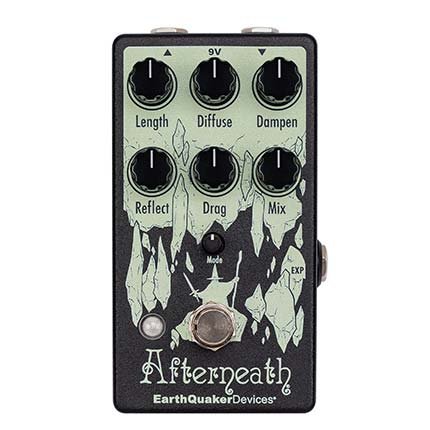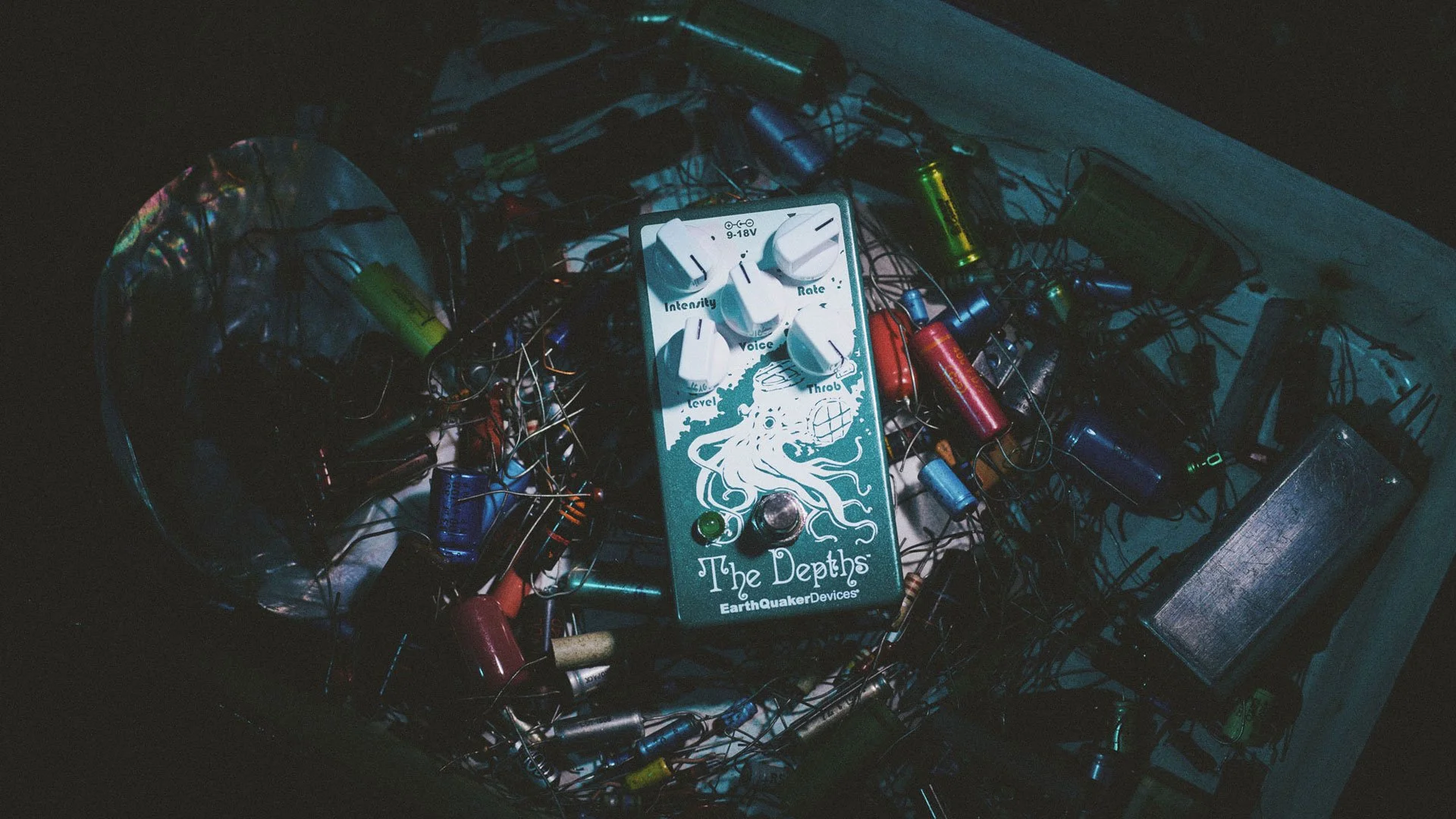Afterneath For Noodlers
Malcolm X Abram
Reverb is among the most common components of a working guitar player's pedalboard. Bassists dig it too. It cuts across genres and styles: clean player, ambient player, death metal, djent-jazz, gypsy-polka, vocals, keys, modular, you name it, there's probably a reverb pedal somewhere adding a little or a lot of space to the signal.
EarthQuaker Devices currently has three reverbs (Afterneath, Astral Destiny, and Ghost Echo) and two more reverbs with delay (Avalanche Run and Dispatch Master). If you want more information about the complete line, please peruse each pedal's product page or check out our handy, dandy roundup REVERBOLOGY also on the EQD blog.
For this edition of "...For Noodlers," we're taking a look at, and a listen to the Afterneath Enhanced Otherworldy Reverberator. The Afterneath was released in 2014 and quickly became one of EQD's most beloved pedals, and not just because it's emblazoned with a cool wizard in a cave on it. It has a bit of a reputation as an ambient player's dream or a tiny chaos machine, but if you only have space for one reverb on your pedalboard...get a bigger pedalboard!
We're kidding. The Afterneath can fill your regular reverb needs with a reasonably classic spring reverb sound. But that's not why most folks get one. Instead, it's because they want to get a little (or a lot) weird, at which the Afterneath excels.
At its root, the Afterneath is a kind of hybrid reverb and short delay pedal. It can do everything from big cavernous, unending, washy reverb to short stuttering digital clusters of delays depending on how you set the ever, so very important Drag knob. This knob is kind of the secret sauce of the Afterneath as it determines the amount of separation between each delay line. Clockwise bunches the lines close for more of a traditional reverb effect, while counterclockwise separates them and at max can give you more of an odd, short stuttering delay sound.
The current version of the pedal, v3, has more cool features including the Mode knob which allows you to control how the Drag knob functions and is a lot of fun when used with an expression pedal or CV. The nine modes are Unquantized, Unquantized with slew, Unquantized volt/octave, Chromatic scale, Major scale, Minor scale, Pentatonic scale, Octaves & Fifths, and Octaves. We're not going to go too deep into the modes, but we'll point out that if you are using an expression pedal or CV and you want your signal to sound like it's being dragged through the space-time continuum, that slurring rise and fall sound, any of the first three modes will get you there. If a bit more control over which notes are pitched is desired, pick one of the scale modes, and the reverberating notes will jump to the dialed-in scale.
The other controls are pretty straightforward, and we'll get into those a bit more below in the audio clips section.
As always, the happy lab-coated minions at Upstairs Bedroom Sound Labs are on a budget. So there's no fancy post-production trickery or groovy vintage outboard gear making everything sound "warm." Rather, we're using a Partscaster with P-90s in the middle position going into our pedalboard with an AMT V1 preamp (modeled on a Vox AC30) pedal. Then the signal hits the Mooer Radar Cab sim using its (Fender modeled) Twin 2X12 cab and into the Focusrite 4i4 USB interface and finally Studio One 5 by PreSonus.
OK, let's make some noise!
CLIP #1 - SPRING
For clip #1 we're just showing that the Afterneath can be tamed and used as a near-standard spring style reverb. It's not the most creative use of the pedal but does show its versatility, and sometimes you just need to add a little space to your signal.
CLIP #2 - NOON
For this next clip, we're entering the cavern. With the controls at noon, you get an interesting bed of repeating reverb, but it doesn't wash out the chords or gather so much energy that it begins to oscillate. You probably wouldn't want to rip off a bunch of speedy 32nd notes runs or very rhythmically complex chord progressions. Though maybe you would!
CLIP #3 - AMBIENT
Here's one for the ambient guitar and keys lovers. The Afterneath is in the ninth mode, which is Octaves. The Diffuse knob can give you sputtering repeats or spacious soundclouds (no, not that one). Settings in this range are great for solo players who want to build a drone tone of reverb. But, again, this works best if your tempo is in no hurry and you're not playing too busy. Pay attention to how the Length and Reflect knobs interact because if one of the two is set to high (clockwise), you can easily drift into an unpleasant ringing tone that most folks aren't into. And remember, the Afterneath reverberations are sensitive to pick attack.
CLIP #4 - SOLO!
Now we're having some fun! Here's a brief solo featuring the Grand Orbiter phaser and the Hizumitas fuzz. It's played over the previous chord progression with the Afterneath in a gentle Spring mode to not crowd the frequencies too much. Hopefully, between all the noodling, you'll notice how the Afterneath functions as a diffused delay, repeating the end phrases as if you were listening in the nosebleed section of your local arena. Since it's a solo and not a grouping of chords, the Length and Reflect are set relatively high for more drama, and the Drag knob is set at about 8 o'clock to let those delay lines stretch out and articulate a bit more. It makes for a great classic rock solo sound. Put your foot up on the wedge monitor, tilt your head back into the (imaginary) spotlight and get to wailing, baby!
CLIP #5 - REFLECT
Now we're going to get a little more into the specifics of a few of the knobs, beginning with Reflect, which is the feedback control. Turning it fully clockwise will lead you into self-oscillation, which is a sound you may love, but it isn't for everyone. For this next clip, all the other Knobs save for the Mix are at zero counterclockwise, giving us longer delay lines (Drag) for more of a ping pong delay effect, a sharper attack (Diffuse), and short reverb decay (Length), and no tone Dampen-ing. Finally, we'll turn the Reflect knob clockwise through the clip so that it's full on by the last chord. Check out how big the cavern can get y'all.
CLIP #6 - LENGTH
OK, you can probably guess how Length works. But here we're in safety mode. We are using a nice short spring-like effect, with the Diffuse at noon for a softer attack, the Drag fully clockwise for a more traditional reverb sound, and the Reflect around 9 p.m., because we don't want the cavern too large or the signal will oscillate earlier. We also have the Dampen at about noon to take off some of the metallic, clangy-sounding high-end. We'll be turning that Length knob clockwise but don't worry; we'll stop short of oscillation. But you'll get the idea. Remember that if you're looking to set it and forget it, don't make the Length too long, or the gathering reverberations will become a heavy ringing sound, and most of your audience's ears will likely be angry at you. Also, if what you are playing is polyphonic, busy, and mid to uptempo, those reverberations will gather pretty quickly.
CLIP#7 - DRAG W/ EXPRESSION PEDAL
The Drag knob is really a hoot. For you table-top pedal and CV-loving players, it can drastically alter whatever signal generator you're running through it. When manipulated in real-time, it literally drags the signal and it sounds pretty weird and cool. Luckily for guitar and bass players, you can use an expression pedal to get similar results. So for fun, here's a taste of some time travel through the cavern with the assistance of the Moog EP-3 expression pedal. The signal chain for this clip is The Warden Compressor into a Boss OC-5 octave pedal into the Grand Orbiter, then the Pyramids Stereo Flanger, The Afterneath, and finally the dearly departed Disaster Transport SR. See ya on the other side.
Well, there you have it! A brief primer on our little Otherworldy Reverberator. Head to the product page for several videos by our talented friends, and more audio clips, including synths!
Malcolm X Abram is a recovering reporter and music writer and a proud 40 year guitar noodler. He lives, works and plays in the bucolic dreamland of Akron, Ohio in an old house with two dogs who don’t really like each other and way too many spiders.






